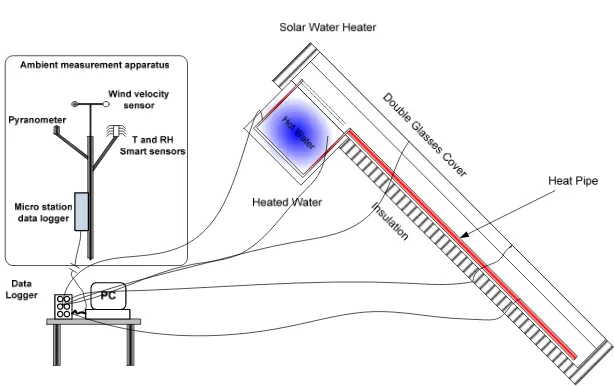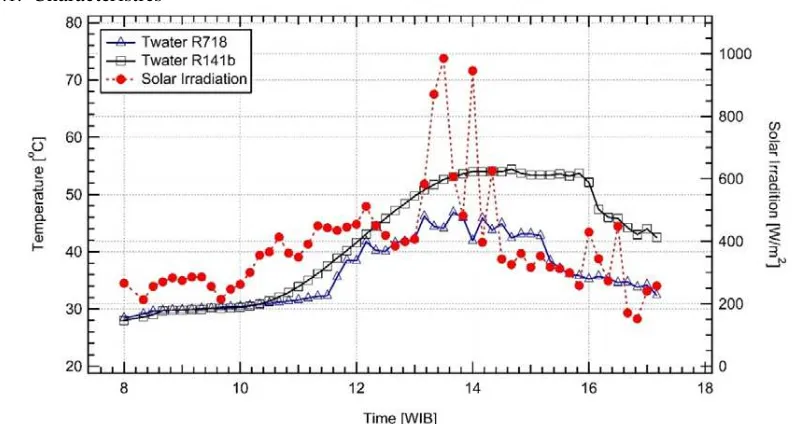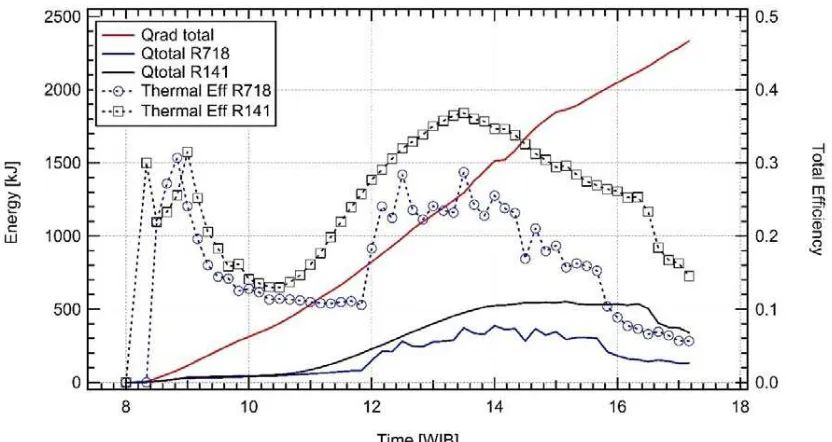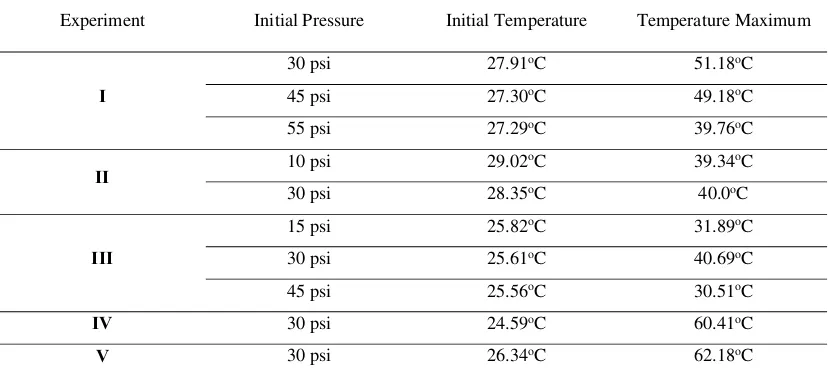PAPER • OPEN ACCESS
Experimental study on a prototype solar water
heater using refrigerant R141b as a transfer fluid
To cite this article: Himsar Ambarita and Tekad Sitepu 2017 IOP Conf. Ser.: Mater. Sci. Eng.237
012014
View the article online for updates and enhancements.
Related content
Experimental study on a prototype of heat pipe solar water heater using refrigerant R134a as a transfer fluid
T Sitepu, J Sembiring and H Ambarita
-Investigation of solar water heater by using flat plate collector and evacuated tubes
J J Jayakanth, S Ramasubramanian, M Chandrasekaran et al.
-Analysis of solar water heater with parabolic dish concentrator and conical absorber
G Rajamohan, P Kumar, M Anwar et al.
Experimental study on a prototype solar water heater using refrigerant
R141b as a transfer fluid
Himsar Ambarita1* and Tekad Sitepu2
1 Sustainable Energy and Biomaterial Centre of Excellent, Universitas Sumatera
Utara, Medan, Indonesia 20155
2 Department of Mechanical Engineering, Faculty of Engineering, Universitas
Sumatera Utara, Medan, Indonesia 20155
Abstract. A prototype of a heat pipe type solar water heater by using refrigerant as a heat transfer fluid is investigated experimentally. The objective is to explore the performance and characteristics of the prototype when it is filled with R141b. A prototype of the solar water heater with flat plate collector is designed and fabricated. In the experiments, two different refrigerants, R141b and R718, are employed, respectively. The initial pressure of transfer fluid is varied from 10 psi to 55 psi. The prototype is exposed to solar irradiation in a location in Medan city. Solar collector temperatures, solar irradiation, water temperature, and ambient temperature are measured. The efficiency of the system is analyzed. The results show that at the same initial pressure, the solar water heater filled with R141b is better than R718. The optimum initial pressure of the solar water heater filled with R141b is 30 psi. Thermal efficiency of the solar water heater at pressure 30 psi can be up to 34%. The main conclusion can be drawn here is that the solar water heater using refrigerant R141b as a transfer fluid results in a better performance in comparison with conventional water heater.
1. Introduction
Hot water is one of the needs of human kind due to weather, production process, industry and or life style. In spite of the fact that Indonesia is a humid tropical country, the need of energy to provide water heater is significant and it increases recently. The need of water heater typically founds in hotel, hospital, restaurant and residential. The energy sources to provide water heater typically from gas, oil, coal, and electric energy. These energy resources result in Greenhouse (GHG) gas emission and burden Indonesian economy due to subsidy for oil price and electricity [1,2,3]. An alternative energy resource to provide hot water is extremely needed. The alternative energy resource to provide water heater is solar energy because it was clean and sustainable. Thus, studies on solar water have received many attentions from researchers.
2
significantly. Arab et al [6] proposed vibrated heat pipe solar water heater. In the experimental work, it was shown that the best performance of the proposed model resulted by pipe filled with 70% transfer fluid. This model is stable and show longer durability. The comparison of thermosyphon and vibrated heat pipe solar water heater are made. The average temperatures of hot water resulted by thermosyphon and vibrated heat pipe type are 35.5oC and 34.5oC, respectively.
Studies of the performance of different fluid in heat pipe type solar water heater are found in literature. Esent and Hesen [7] compared the performance of R410a, R407C, and R134a as a transfer fluid. The results showed that higher performance is shown by R410a. Josep and Yakasai [8] reported the performance comparison of R12, R134a, and ethanol as a transfer fluid in heat pipe type solar water heater. The results revealed that R134a show a better efficiency and higher hot water temperature.
The above studies showed that organic fluid that usually used for refrigeration unit can be used as a transfer fluid in heat pipe type solar water heater. There is a strong effect of refrigerant type that usually used as a transfer fluid. In this study, we focus on using R141b as a transfer fluid in a heat pipe type solar water heater. However, the performance and characteristics need to be explored. The objective of this study is to explore the performance of R141b as a transfer fluid in a heat pipe solar water heater. The optimum operational condition, in term of initial pressure, is investigated. The results are expected to supply the necessary information on development high performance solar water heater.
2. Methods
In order to perform the study, a prototype as an experimental set up has been designed and fabricated. Figure 1 shows the schematic diagram of the experimental set up.
It consists of heat pipe type solar water heater and data acquisition system. The solar water heater consists of a flat plate type solar collector, heat pipe, and hot water tank. The dimension of collector area is 1000 mm ×200 mm and the thickness is 200 mm. In order to reduce the heat transfer loss from the collector, it is covered with insulation made of 100 mm of rock wool. The distance of glass cover to plat absorber is 100 mm. The heat pipe is placed on the absorber plate with a distance of 100 mm.Several parts of the heat pipe are passed through a water tank. The water tank is placed beneath the top part of the solar collector. The volume of the water tank is 5 liters. In order to perform experiment, a data acquisition system is used. The system consists of HOBO micro station datalogger and temperature measurement system. There are 20 thermocouples are used to measure temperatures. The sensors are made ofJ-type thermocouples with uncertainly equal to 0.1oC. Agilent 34972, multi channels data logger is used to record temperatures with interval of 1 minute. The solar radiation is measured using HOBO pyranometer smart sensor. The ambient temperature and relative humidity (RH) is measured using HOBO temperature RH smart sensor with an accuracy of 0.2oC and
±2.5% RH, respectively. The wind speed around the experimental apparatus is measured with HOBO wind speed smart sensor with accuracy ±1.1 m/s.
In order to make performance comparison of the solar water heater, a similar solar water heater is also made but filled with different transfer fluid. In this experiment, the transfer fluid fills the heat pipe and it is evacuated at a certain pressure.
3. Results and Discussions
The working mechanism of a heat pipe solar water heater was explained as follows. The refrigerant as a transfer fluid filled the pipe. When the solar water heater is exposed to solar irradiation, the received heat will evaporate the refrigerant. The refrigerant vapor flows up to the hot water tank. In the tank, the water cools the refrigerant vapor and converted it into liquid refrigerant. The liquidrefrigerant will flow down and cycle repeats. In the experiments, temperatures and solar irradiation are measured and the performance are analysed. The results are discussed below.
3.1. Characteristics
4
Figure 2 shows temperatures history of the hot water inside the tank for solar water heater with transfer fluid R718 and R141b. Solar irradiation during the experiment is also shown in the figure. The figure shows that solar irradiation increases as time increase. However, this only for time before 14.00 local time. After that, solar irradiation decreases as time increase. The maximum solar irradiation is 1000 W/m2 and it was captured between 13.00 and 14.00 local time. It can be seen that at the present experiment, the weather condition is categorized cloudy. The measured solar irradiations are below the theoretical clear sky solar radiation. When the R718 is used as transfer fluid, temperature of the hot water reaching its maximum value of 46.88oC at 13.40 local time. After reaching the maximum value, the temperature maximum decrease with increasing time. This is because solar irradiation and ambient temperature are decreased. The heat loss to ambient is significant. The same trends are also shown by solar water heater when the heat pipe filled with R141b as transfer fluid. In this case the temperature maximum is 54.4oC and captured at 14.34 local time. These values suggest that temperature of the hot water from R141b is higher than R718.
It can be seen clearly that there is a relation of solar irradiation with temperature of the hot water in the tank. When solar irradiation increases, by noon, the temperature of the hot water increases significantly. On the other hand, after the maximum temperature is reached, the solar irradiation not effectively enhances the hot water temperature. There are three reasons for this. The first is that temperature of the hot water is already high. The second ambient temperature is already went down and the third, solar irradiation is not sufficient enough to enhance the temperature of the water.
Figure 3. Total heat and thermal efficiency of the system
total heat utilized increase with increasing time. On the other hand, if the solar irradiation is not sufficient enough to overcome the heat loss, the total utilized decrease with increasing time. This is because temperature of the hot water in the tank is higher than ambient temperature. These facts can be seen clearly in the figure. The total heat utilized by solar water heater filled with R141b increases as time increase and reaching maximum value of 552 kJ at 14:37 local time. After this, the utilized energy decreases with increasing time. This is due to heat loss to ambient. For the solar water heater filled with R718, the maximum total heat utilized is 388 kJ at 13:39 local time. Similar with the previous water heater, the total utilized heat decreases with increasing time. This is because the heat loss to ambient. This value suggests that solar water heater filled with R141b is better than filed with R718.
3.2. Effects of the initial pressure
Based on the above experiments, the performance comparison of the solar water heater with R718 and R141b as transfer fluid has been carried out. The results show that R141b show the better performance. In the next experiment, the operational parameter is investigated. The parameter is initial pressure of the heat pipe. There are six groups of experiments have been carried out. The initial pressure varies from 10 psi to 45 psi. The initial and maximum temperatures of the hot water tank for all experiments are shown in Table 1.
Table 1 Effects of the initial pressure on the performance of solar water heater filled with R141b
Experiment Initial Pressure Initial Temperature Temperature Maximum
I
6
best operational condition for the solar water heater filled with R141b is initial pressure 30 psi.
4. Conclusions
In this work, a prototype heat pipe type solar water heater has been designed and tested by exposing under solar irradiation in Medan city of Indonesia. The performances of two different refrigerants are compared. The results show that the performance R141b is better that R781. The effect of initial pressure of the solar water heater with refrigerant R141b shows that the initial pressure of 30 psi is the optimum initial pressure. It is suggested to develop heat pipe type solar water heater by employing R141b as a transfer fluid. For the present prototype with initial pressure of 30 psi, thermal efficiency and maximum hot water resulted by the solar water heater can be up to 34% and 62.18oC, respectively.
Acknowledgments
The authors gratefully acknowledge that the present research is supported by Ministry of Research and Technology and Higher Education Republic of Indonesia. The support is under the research grant TALENTA-USU of Year 2017.
References
[1] Gov. of Indonesia Presidential Y Decree No No 61 Year 2011, National Action Plan
For Reducing Greenhouse Gas Emissions.
[2] Gov. of Indonesia, 2016, First Nationally Determined Contribution Republic of
Indonesia.
[3] IPCC, 2006, Guidelines for National Greenhouse Gas Inventories.
[4] S. Jaisankar, J. Ananth, S. Thulasi, S.T., Jayasuthakar, K.N. Sheeba, 2011 Renewable and Sustainable Energy Reviews15(6), 3045-50.
[5] W. Chun, Y.H. Kang, H.Y. Kwak, Y.S.Lee, 1998 Applied Thermal Engineering19, 807-17
[6] M. Arab, M. Soltanieh, M.B. Shafii, 2012 Experimental Thermal and Fluid Science42, 6-15
[7] M. Esent, H. Hesen, 2005 Solar Energy79, 459 - 468



